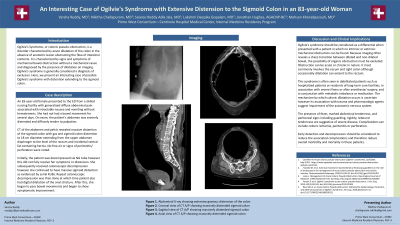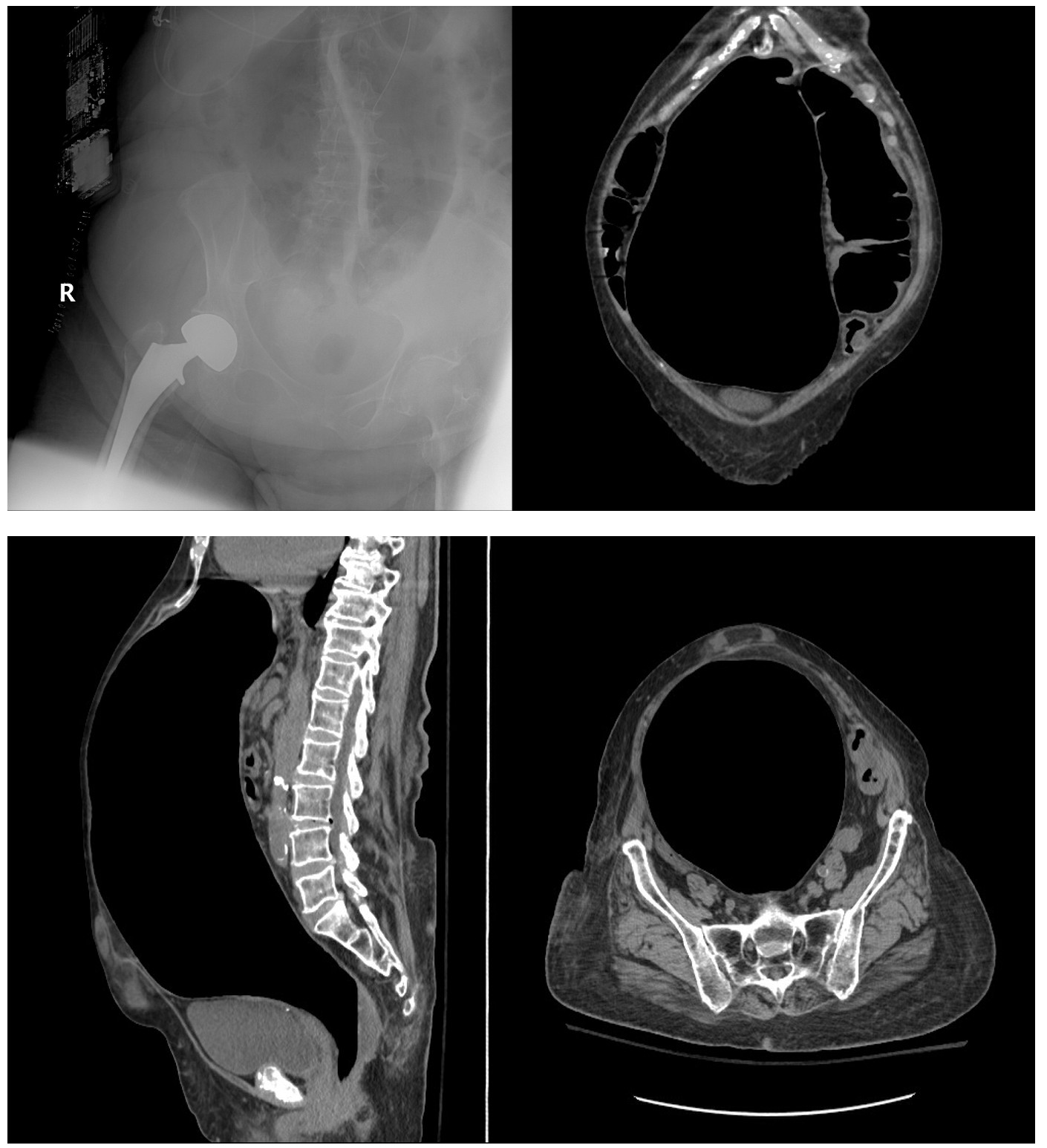Sunday Poster Session
Category: Colon
P0337 - An Interesting Case of Ogilvie’s Syndrome With Extensive Distention to the Sigmoid Colon in an 83-Year-Old Woman
Sunday, October 27, 2024
3:30 PM - 7:00 PM ET
Location: Exhibit Hall E

Has Audio
- VR
Varsha Reddy, MD
Centinela Hospital Medical Center
Inglewood, CA
Presenting Author(s)
Varsha Reddy, MD1, Saisree Reddy Adla Jala, MD2, Nikitha Chellapuram, MD2, Jonathan Hughes, 2, Lakshmi Deepika Gopalam, MD1, Mohsen Kheradpezhouh, MD1
1Centinela Hospital Medical Center, Inglewood, CA; 2Centinela Hospital Medical Center, Los Angeles, CA
Introduction: Ogilvie’s Syndrome, or colonic pseudo-obstruction, is a disorder characterized by dilatation of the colon in the absence of anatomic lesion obstructing the flow of intestinal contents. It is characterized by signs and symptoms of mechanical bowel obstruction without a mechanical cause and diagnosed by the presence of dilatation on imaging. We present a case of possible Ogilvie’s syndrome with distention extending up to the sigmoid colon.
Case Description/Methods: An 83-year-old female presented to the ED from a skilled nursing facility with generalized diffuse abdominal pain associated with nausea and vomiting and no bowel movement for several days. The patient's abdomen was severely distended and diffusely tender to palpation. CT abdomen and pelvis revealed massive distention of the sigmoid colon with gas and sigmoid colon distention to 18 cm diameter extending from the upper abdomen diaphragm to the level of the rectum and ventral fat-containing hernia. Patient was initially decompressed via NG tube without resolution of symptoms or distension. She then subsequently received colonoscopic decompression however continued to have massive sigmoid distention as visualized on serial KUBs. Repeat colonoscopic decompression was done at which time patient also had anal stricture digitally dilated. After this, she began to pass bowel movements and began to improve symptomatically.
Discussion: Ogilvie’s syndrome should be considered when presented with a patient in which no mechanical obstruction can be found. It most commonly presents in hospitalized patients or in residents of long-term care facilities, in association with a severe illness or after surgery, and in conjunction with metabolic imbalance or medication. This syndrome most commonly involves the cecum and right colon although occasionally dilatation can extend to the rectum. Obstruction can be acute or chronic in nature. The mechanism by which colonic dilatation occurs is uncertain however its association with trauma and pharmacologic agents suggest impairment of the autonomic nervous system. The presence of fever, marked abdominal tenderness, peritoneal signs including guarding, rigidity, rebound tenderness are suggestive of more severe disease or complications including colonic ischemia, peritonitis or perforation. Early detection and decompression can help to reduce the associated complications and therefore reduce morbidity and mortality in these patients.

Disclosures:
Varsha Reddy, MD1, Saisree Reddy Adla Jala, MD2, Nikitha Chellapuram, MD2, Jonathan Hughes, 2, Lakshmi Deepika Gopalam, MD1, Mohsen Kheradpezhouh, MD1. P0337 - An Interesting Case of Ogilvie’s Syndrome With Extensive Distention to the Sigmoid Colon in an 83-Year-Old Woman, ACG 2024 Annual Scientific Meeting Abstracts. Philadelphia, PA: American College of Gastroenterology.
1Centinela Hospital Medical Center, Inglewood, CA; 2Centinela Hospital Medical Center, Los Angeles, CA
Introduction: Ogilvie’s Syndrome, or colonic pseudo-obstruction, is a disorder characterized by dilatation of the colon in the absence of anatomic lesion obstructing the flow of intestinal contents. It is characterized by signs and symptoms of mechanical bowel obstruction without a mechanical cause and diagnosed by the presence of dilatation on imaging. We present a case of possible Ogilvie’s syndrome with distention extending up to the sigmoid colon.
Case Description/Methods: An 83-year-old female presented to the ED from a skilled nursing facility with generalized diffuse abdominal pain associated with nausea and vomiting and no bowel movement for several days. The patient's abdomen was severely distended and diffusely tender to palpation. CT abdomen and pelvis revealed massive distention of the sigmoid colon with gas and sigmoid colon distention to 18 cm diameter extending from the upper abdomen diaphragm to the level of the rectum and ventral fat-containing hernia. Patient was initially decompressed via NG tube without resolution of symptoms or distension. She then subsequently received colonoscopic decompression however continued to have massive sigmoid distention as visualized on serial KUBs. Repeat colonoscopic decompression was done at which time patient also had anal stricture digitally dilated. After this, she began to pass bowel movements and began to improve symptomatically.
Discussion: Ogilvie’s syndrome should be considered when presented with a patient in which no mechanical obstruction can be found. It most commonly presents in hospitalized patients or in residents of long-term care facilities, in association with a severe illness or after surgery, and in conjunction with metabolic imbalance or medication. This syndrome most commonly involves the cecum and right colon although occasionally dilatation can extend to the rectum. Obstruction can be acute or chronic in nature. The mechanism by which colonic dilatation occurs is uncertain however its association with trauma and pharmacologic agents suggest impairment of the autonomic nervous system. The presence of fever, marked abdominal tenderness, peritoneal signs including guarding, rigidity, rebound tenderness are suggestive of more severe disease or complications including colonic ischemia, peritonitis or perforation. Early detection and decompression can help to reduce the associated complications and therefore reduce morbidity and mortality in these patients.

Figure: A) AXR showing extensive gaseous distension of the colon
B) Coronal view of CT abdomen and pelvis showing massively distended sigmoid colon
C) Sagittal view of CT abdomen and pelvis showing massively distended sigmoid colon
D) Axial CT view of abdomen and pelvis showing massively distended sigmoid colon
B) Coronal view of CT abdomen and pelvis showing massively distended sigmoid colon
C) Sagittal view of CT abdomen and pelvis showing massively distended sigmoid colon
D) Axial CT view of abdomen and pelvis showing massively distended sigmoid colon
Disclosures:
Varsha Reddy indicated no relevant financial relationships.
Saisree Reddy Adla Jala indicated no relevant financial relationships.
Nikitha Chellapuram indicated no relevant financial relationships.
Jonathan Hughes indicated no relevant financial relationships.
Lakshmi Deepika Gopalam indicated no relevant financial relationships.
Mohsen Kheradpezhouh indicated no relevant financial relationships.
Varsha Reddy, MD1, Saisree Reddy Adla Jala, MD2, Nikitha Chellapuram, MD2, Jonathan Hughes, 2, Lakshmi Deepika Gopalam, MD1, Mohsen Kheradpezhouh, MD1. P0337 - An Interesting Case of Ogilvie’s Syndrome With Extensive Distention to the Sigmoid Colon in an 83-Year-Old Woman, ACG 2024 Annual Scientific Meeting Abstracts. Philadelphia, PA: American College of Gastroenterology.
